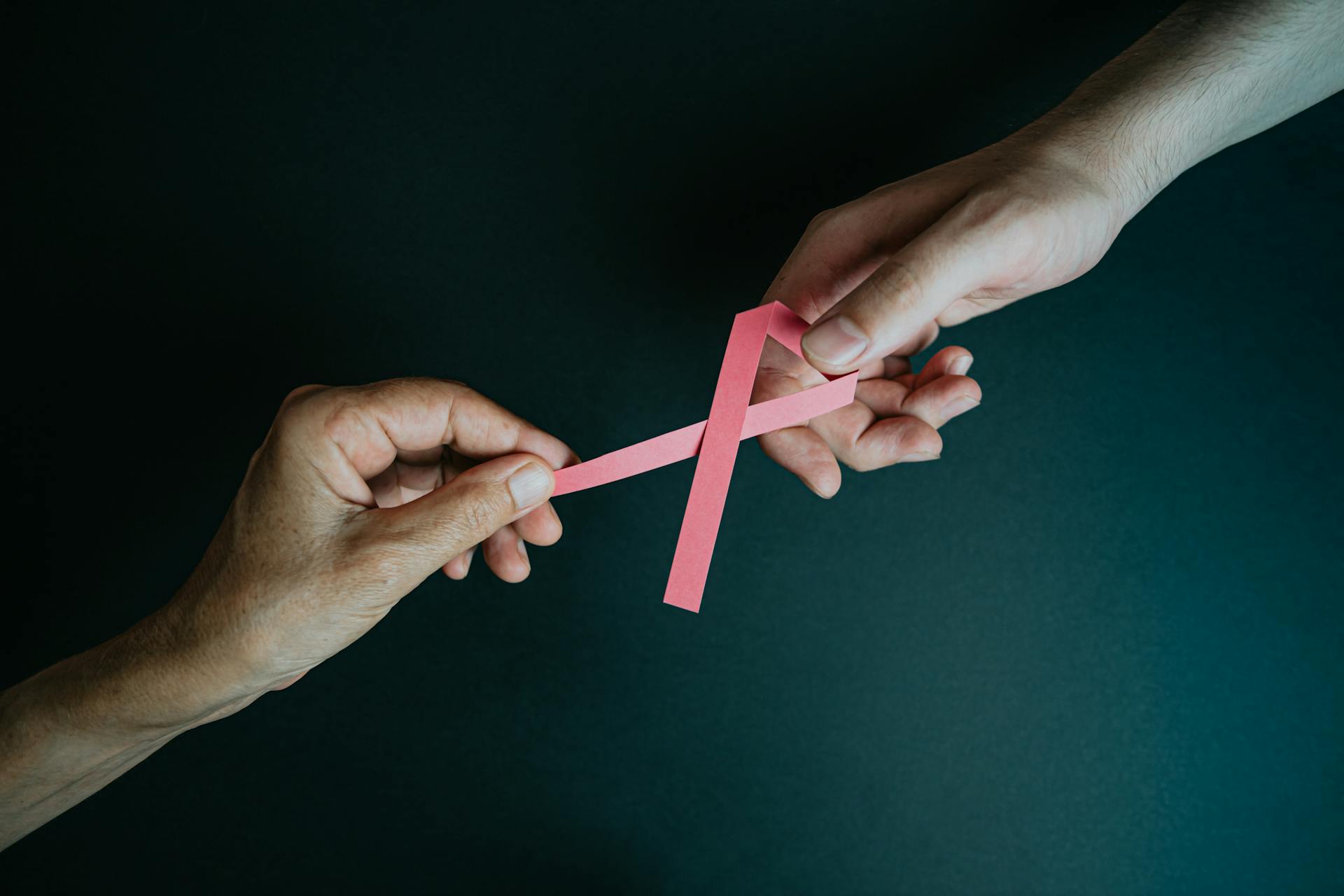
A swollen nipple on a female dog can be a concerning symptom for any pet owner.
Mammary gland tumors are a common cause of swollen nipples in female dogs, with a 50% chance of being malignant.
These tumors can be benign or malignant, and they can grow rapidly.
If you notice any unusual lumps or swelling on your dog's nipples, it's essential to have them checked by a veterinarian.
Broaden your view: Why Are My Male Dogs Nipples Enlarged
What Causes?
Mastitis in dogs can be caused by a bacterial or fungal infection, but it's not the only reason for a swollen nipple on a female dog.
A sudden weaning or the death of a puppy can cause milk to build up in the breast, leading to mastitis. This is because the milk has nowhere to go, causing inflammation in the mammary gland.
The size of the litter doesn't affect the chances of infection in the mother, but larger litters can make it easier for bacteria to move into the glands. This is because the teat canals remain open for longer, allowing bacteria to enter.
Take a look at this: Female Dog Lactating but Not Pregnant
Any dog can develop mastitis at any stage in life, not just post-partum females. This includes male canines and females who are not pregnant or nursing.
In these cases, the inflammation may be a clinical sign of breast cancer, so it's essential to see a vet at the first sight of symptoms.
Clinical Signs and Symptoms
If your female dog has a swollen nipple, it's essential to be aware of the possible clinical signs and symptoms.
Puppies not gaining weight can be an early indication of mastitis, a condition where the mammary glands become inflamed.
A nursing dog may become reluctant to feed the puppies due to constant discomfort, soreness, and pain.
Slight redness around the nipple, fever, palpable mass, discolored mammary gland, inflamed teats, loss of appetite, weight loss, and lethargy are all potential physical symptoms of mastitis.
If left untreated, mastitis can lead to gangrene, septic shock, abscesses, or even become deadly.
Additional reading: Dog Lifespan by Weight
The infection can spread quickly, making your dog extremely sick or even causing death.
Here are some common clinical signs of mastitis in dogs:
- Slight redness around the nipple
- Fever
- Palpable mass
- Discolored mammary gland
- Inflamed teats
- Loss of appetite
- Weight loss
- Lethargy
If your dog is showing any of these symptoms, it's crucial to seek veterinary attention immediately.
Diagnosis and Treatment
Diagnosing a swollen nipple on your female dog requires a visit to the vet. They'll ask about your dog's health history and the onset of symptoms, then palpate her breasts to check for any abnormalities.
The vet may take a sample of milk from the affected teat to examine under a microscope for bacteria or pus. This can help determine the best course of treatment.
In addition to a physical exam, your vet may recommend a complete blood count (CBC) to determine the severity of the infection, or an ultrasound to check for abscesses or tumors.
Treatment typically involves a combination of antibiotics, warm compresses, and milking out the affected gland several times a day. Your vet may also prescribe non-steroidal anti-inflammatory drugs (NSAIDs) to reduce inflammation and manage pain.
Broaden your view: Female Dog Prolapse
In severe cases, hospitalization may be required to administer IV fluids, antibiotics, and supportive care. In some cases, surgery may be necessary to remove the affected gland.
If your vet recommends antibiotics, be sure to monitor your dog for any adverse reactions, especially if she's nursing puppies. And if your dog is experiencing pseudopregnancy or doesn't have puppies to nurse, your vet may advise against hand-milking to allow the milk to dry up naturally.
Here's a summary of the possible diagnostic tests and treatments:
- Complete Blood Count (CBC)
- Ultrasound
- Thyroid profile
- Antimicrobial medication
- NSAIDs
- Warm compresses
- Milking out the affected gland
- Surgery (in rare cases)
Diagnosing
Diagnosing mastitis in dogs typically starts with your vet asking about your dog's health history and the onset of symptoms. They'll then perform a physical examination, specifically palpating the dog's breasts to check for any abnormalities.
Your vet may take a sample of milk from the affected teat to examine under a microscope for bacteria or pus (white blood cells). This can help them determine the cause of the mastitis.
A complete blood count (CBC) may be performed to determine the severity of the infection. This can help your vet decide on the best course of treatment.
An ultrasound may be recommended to check for abscesses or tumors in the affected teat. This can help your vet rule out any underlying conditions that may be contributing to the mastitis.
A thyroid profile may also be performed to rule out hypothyroidism, which can sometimes cause mastitis-like symptoms.
A unique perspective: Dog Names Female Start with S
Treatment
Treatment of mastitis in dogs typically involves a combination of antibiotics, warm compresses, and other supportive care. The veterinarian will prescribe antimicrobial medication to stop the infection from spreading and reduce damage to the mammary tissue.
In severe cases, hospitalization may be required to administer IV fluids, antibiotics, and supportive care for several days. This is usually necessary if the bacteria enter the bloodstream and cause sepsis.
Applying warm compresses to the affected gland can help keep the milk ducts clear and reduce pain. This should be done several times a day, but in cases where there are no puppies to nurse, hand-milking should be avoided to allow the milk to dry up.
If this caught your attention, see: How to Care for a Female Dog in Heat

The veterinarian may also prescribe NSAIDs to reduce inflammation and manage pain. In rare cases, surgery may be necessary to remove the affected mammary gland if the infection causes significant damage.
Costs for diagnostics and treatment can range from $300 to $800, depending on the severity of the disease. Having a pet insurance plan can help protect your finances in case of a surprise illness or accident.
Here are some common treatments for mastitis in dogs:
- Aggressive antibiotics
- Warm compresses applied to the affected teat
- Expressing the infected teat to alleviate pain and prevent abscess formation
- Supplementing puppies with formula if they need to be separated from the affected teat
Prevention and Recovery
Preventing mastitis in female dogs is crucial, and one of the best ways to do so is by spaying them, which also decreases the risk of other conditions like uterine infections and mammary tumors.
Keeping the living area sanitary is also essential, especially when breeding dogs, to reduce the risk of mastitis. A dry and clean whelping box with frequently changed bedding can make a big difference.
Regular bathing, especially in lactating dogs, can also help keep the mammary glands clean and prevent mastitis. Clipping the puppies' nails to prevent them from scratching their mother's skin is another important step.
The prognosis for dogs with mastitis is good, and with appropriate treatment, the symptoms usually resolve in two to three weeks.
You might like: Symptoms of Mammary Gland Cancer in Dogs
Prevention

Spaying your female dog is a simple yet effective way to prevent mastitis. This one-time procedure can also decrease the risk of other conditions like uterine infections and mammary tumors.
Keeping the living area sanitary is crucial in preventing mastitis. Unhygienic conditions put your dog at more risk for bacterial and fungal infections.
Regular bathing is essential for lactating dogs to keep their mammary glands clean. This helps prevent mastitis and other infections.
Clipping your puppy's nails is a good idea to prevent them from scratching their mother's skin. This can lead to infection and mastitis.
To reduce the risk of infection, ensure that all mammary glands are used for nursing. This helps prevent mastitis and other complications.
Expand your knowledge: Ear Infections in Goldendoodles
Recovery
Recovery is a crucial part of the mastitis healing process. With proper treatment, the symptoms usually resolve in two to three weeks.
Acute mastitis requires immediate and aggressive treatment to ensure a full recovery. Your veterinarian will determine the best treatment plan for your dog and schedule follow-up visits to ensure the infection is gone.
If your dog is still nursing, your vet will recommend a proper diet to help her recover. However, if the dog isn’t recovering fast enough and can’t care for her puppies, you will need to hand-feed them according to your vet’s instructions.
In more severe cases or if a systemic infection occurs, the prognosis is less enthusiastic, even with treatment. It's essential to work closely with your veterinarian to ensure the best possible outcome.
Swollen nipples may subside quickly, especially with the right care, but a vet visit is worth every penny if you suspect a more serious issue at hand. If the swelling lasts for multiple weeks and doesn’t seem to get better, it’s time for a trip to the vet.
Dog nipples can stay enlarged for 2-3 weeks after the heat cycle and usually get back to normal by themselves unless there’s an underlying medical condition.
See what others are reading: Best Dog Food for Malnourished Dogs
Pregnancy and Heat Cycle
After a heat cycle, it's normal for dog nipples to enlarge.
Dog nipples can stay enlarged for 2-3 weeks after the heat cycle and usually get back to normal by themselves unless there's an underlying medical condition.
Pseudopregnancy is another common cause of enlarged nipples, which can occur 4-9 weeks after the heat cycle, with some vets noting a narrower range of 6-8 weeks.
If your dog's nipples are significantly enlarged for more than 3 weeks, it's a good idea to consult your vet.
Here are some possible underlying issues that may cause enlarged nipples:
- Infection
- Mammary hyperplasia
- Thyroid issues
- Pregnancy
- Mastitis
- Pseudopregnancy
In case pregnancy can't be 100% ruled out, your vet might run more tests, such as blood tests for relaxin, a pregnancy hormone, or ultrasound or x-rays.
Worth a look: Female Dog Pregnancy Stages
Frequently Asked Questions
How long do female dog nipples stay enlarged after heat?
Female dog nipples can take up to 3 months to return to normal size after heat, and may not fully shrink back down.
Featured Images: pexels.com


